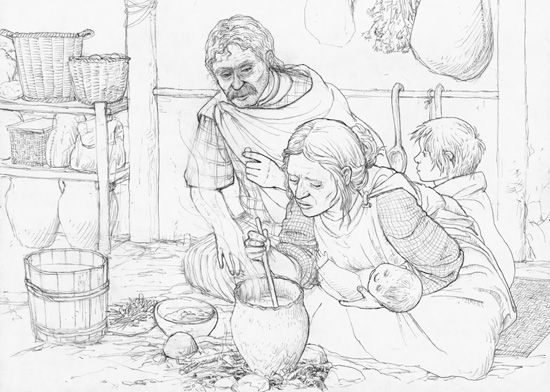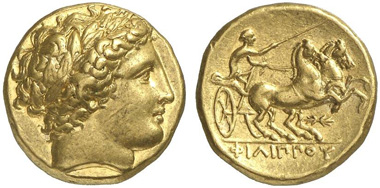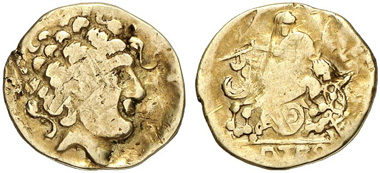With the kind permission of the MoneyMuseum
Our series ‘The People of Zurich and their Money’ takes you along for the ride as we explore the Zurich of times past. In this first chapter, we’ll be eavesdropping on a conversation from the 3rd century BC between a Celtic farmer and his wife. Much like a good DVD, this conversation comes with a sort of ‘making of’ – a little numismatic-historical backdrop to help underscore and illustrate this conversation.
Middle of the 3rd century BC. A Celtic farmer is talking to his wife. Drawn by Dani Pelagatti / Atelier bunterhund. Copyright MoneyMuseum Zurich.
Celtic farmer: Look, what the merchant gave to me in exchange for our wool.
Wife: (rather uninterested) What’s that?
It’s a coin.
Show it to me. (break) And what do you need it for?
It’s made of gold.
Ah, jewelry. But the smith has forgotten the holes. How shall I sew this to your doublet?
This is no jewelry. This is money.
(irritated) And what is money?
Do you remember when we bought my arms?
The sword, the spear and the shield? O yes, I remember. We had to give ten pigs to the smith in exchange for your arms.
And do you remember that he didn’t really want the pigs, because his own flock was big enough at that time? He wanted to have grain, but we couldn’t give grain to him. We’d had a bad harvest, too.
I do remember it!
And if we’d owned such a coin, we would have given that coin to him instead of the pigs. And he would have changed it into grain.
You think, this piece of metal is a means of exchange?
Indeed, that’s what the merchant told me. He comes from beyond the river Rhine, from the great wood, and he traveled a lot while he was a young man. He was even in Greece.
Greece, where’s that?
That’s far, far away. The merchant went there with his tribe. They wanted to find new land, where they could settle. But the locals, who were called Macedonians, were more powerful then they were. They defeated his tribe, killed most of the warriors and forced the survivors to fight in the Macedonian army.
(frightened) Really?
Indeed. The warriors of the merchant’s tribe fought for the Macedonians. And for that they received a coin like this each month. And with all these coins they could buy everything their family needed for everyday life.
And was the merchant really in Macedonia?
Yes, most of his people stayed there. But he returned. And he brought with him a bag full of coins. And now he pays for what he needs with these coins. In fact, I didn’t really want anything of his goods. But he needed wool …
(interrupts him) So that’s how he palmed that coin off on you? You’re so easy to cheat. What shall we do with this coin?
We’ll keep it. One day we’ll buy something.
Philip II. Gold stater, Pella, 340-328. From Künker auction 216 (2012), 251.
Making of:
Between the years 280 and 277 BC, Celtic tribes from the Western Balkans of Bohemia and Moldova attacked rich and abundant Macedonia and Greece. Among them were Western Celts as well, and these likely included a group that had originally settled in the region we know today as the Black Forest.
The Celtic invasion initially swept aside all opposition. In 280 BC, the Macedonian King, Ptolemy Keraunos, was killed in battle. In 279 BC, the sanctuary of Delphi was conquered and pillaged. Only after this did the Greeks succeed in building up a common defense that managed to crushingly defeat the Celtic army. In Macedonia, Antigonos Gonatas, aspirant to the Macedonian royal throne, was also organizing a battle against the intruders. He too defeated the Celtic army, but rather than expelling the tribal warriors, he took them into his service. After all, he was competing for the Macedonian throne and needed as many good mercenaries as he could possibly find. The Celts fought for Antigonos for a salary of one gold stater per month right up until their group was annihilated in 274 BC by Pyrrhus, one of Antigonos’ rivals.
Very few Celts were to survive the battles that took place between the years of 280 and 274 BC, and even fewer made the long trip back to their native land. But those who did were responsible for bringing the first coins to the West, including the present-day region of Switzerland.
At first, there really wasn’t a great deal one could do with the new means of exchange – the economy of the time was primarily based on self-contained farmsteads that essentially sustained themselves. Those few things that couldn’t be produced directly on the land were procured by travelling merchants in exchange for production surpluses, and so there was little use for money and coins. They remained, much like you’ll hear in our audio dramatization, more of a curiosity that had no bearing on daily life.
Celts. Helvetii. AV-1/4 stater, 2nd century BC. From Künker auction 204 (2012), 77.
This only began to change during the course of the 2nd century. Recent research suggests that the advent of Celtic coinage, which emulated Greek prototypes in both weight and face design, may have been linked to the looming threat posed by Germanic tribes. Much as the Greek rulers had done, Celtic tribes who felt threatened by the Germanic peoples ‘bought’ mercenaries and paid them. They minted their own money for these purposes, which was very similar in form to what the Celtic warriors were already familiar with from their mercenary service in Greece and Lower Italy.
A developed monetary economy must only have existed in the region of present-day Zurich since the beginning of the first half of the 1st century BC. This is evidenced by the existence of small change; something a society only needs once its daily necessities become market-based. Wonderful proof of this evolution of the monetary economy is offered by a one-and-a-half centner of heavy clumps of melted down small change that was discovered in 1890 during construction work in the area of what is now Bahnhofsstrasse 3.
Be sure to catch the next instalment, which finds two men chatting around 200 years later at a customs station in Turicum!
You can find all other parts of the series here.
The texts and graphics come from the brochure of the exhibition of the same name in the MoneyMuseum, Zurich. Excerpts with sound are available as video here.






